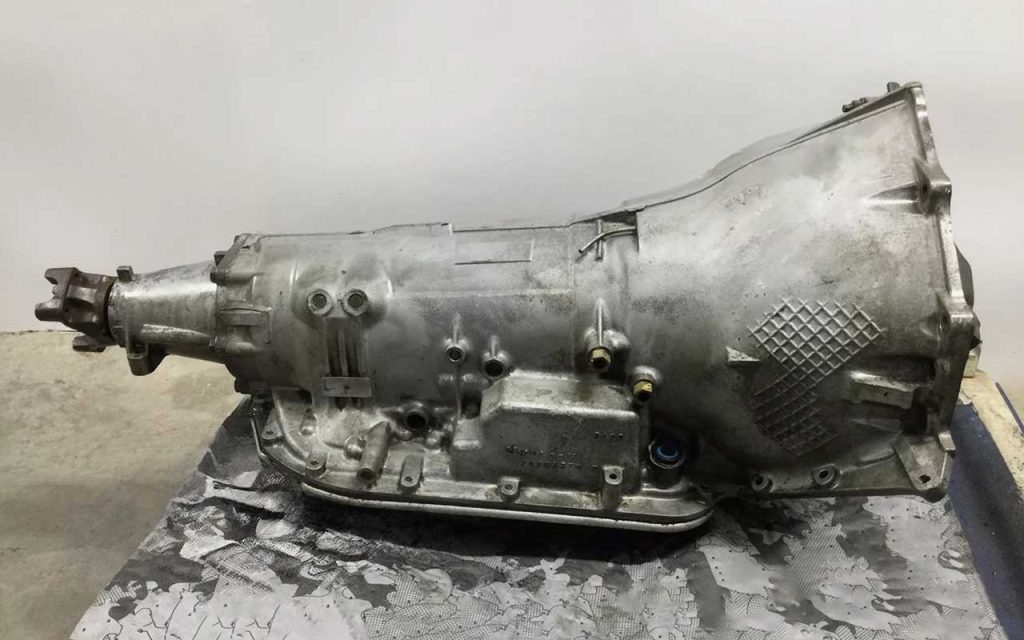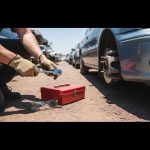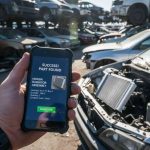If you need to replace your transmission but don’t want to spend a lot of money, buying a used transmission from a junkyard could save you up to 70% compared to buying a new one. You can find a reliable junkyard transmission using u-pull-it.com, which lists thousands of local junkyards to help you find the right used transmission for your car.
Cost Savings and Benefits
The main reason people buy a used transmission from a salvage yard is the money they save. You can save 50-70% compared to the price of a new one. This is especially helpful if you have an older car and spending money on a new transmission doesn’t make sense. Plus, a used transmission has already gone through most of its value drop, so you won’t lose much value if you decide to sell your car later.
- Cost Breakdown:
- Used Transmission: $800 – $1500 (from a junkyard)
- New Transmission: $3000 – $4000+
Buying used parts not only saves money but also helps the environment by supporting auto recycling. Learn about other affordable used parts here.
How Do Junkyard Transmissions Get There?
Many cars end up in junkyards because of accidents, old age, or other problems that don’t affect the transmission. For example, a car that was in a crash might still have a perfectly good transmission that ends up in a salvage yard. The key is that the transmission might still be in great condition, even if the rest of the car is junk. Junkyards inspect the cars they get and save any auto parts that are still in good shape.
Finding the Right Transmission for Your Car
1. Identify Your Needs
To find the right used transmission, you need to know important details about your car, such as:
- Make and Model: Each car needs a specific transmission type.
- Vehicle Identification Number (VIN): This number helps confirm if the part is compatible.
- Automatic or Manual Transmission: Make sure you know if you need an automatic or manual transmission.
2. Use Interchange Systems
Junkyards use interchange systems to match compatible transmissions across different cars. This means a transmission from a Chevy might fit a GMC of the same year. To save time, find out if a used Chevy Silverado 1500 transmission is compatible with your truck.
3. Online Resources
Use websites like u-pull-it.com to find junkyards in your area that have the right transmission for your car. This saves you time driving around looking for the right part.
Ensuring High Quality Beyond Basic Inspection
1. Reputation of the Junkyard
It’s important to buy from a junkyard that has a good reputation. Look for online reviews or ask friends and family for recommendations. A junkyard with good reviews is more likely to sell you quality parts.
2. Certification and Testing
Some junkyards offer certifications or testing for the transmission before they sell it. This can give you more confidence that the part is in good condition. Always ask if the transmission has been tested.
3. Professional Inspection
If possible, bring a certified mechanic or a knowledgeable friend with you to inspect the transmission. They can help you spot any problems that you might not see.
Detailed Compatibility Checks
1. Transmission Codes
Make sure to check the transmission codes or part numbers on the transmission you’re interested in. Even small differences can mean the part won’t work for your car. Check the car’s manual or talk to a mechanic if you’re unsure.
2. Consult Manufacturer Guidelines
You can also check the vehicle’s manufacturer guidelines or ask a dealership to help confirm compatibility. This ensures the transmission will fit and work correctly in your car.
Inspecting a Junkyard Transmission
When buying a transmission from a junkyard, always inspect it before buying. Follow these steps to make sure you’re getting a good deal:
- Check for Visible Damage: Look for cracks, leaks, or rust.
- Ask About Mileage: Lower mileage usually means it will last longer.
- Ask for a Warranty: Many good junkyards offer a 30 to 90-day warranty on transmissions. This can save you if there’s an issue with the transmission after you install it.
- Check Fluid Color: The transmission fluid should be red or pink. If it’s brown or smells burnt, it might be damaged.
Negotiation Tips
1. Know the Market Value
Before you go to the junkyard, do some research to find out the average price for the type of transmission you need. This will give you a better idea of what’s a fair price.
2. Be Ready to Walk Away
If the price seems too high, be prepared to walk away. Sometimes, just showing that you’re willing to leave will make the seller lower the price.
Junkyard Visit: The Removal Process
When you find a transmission you want, be ready to remove it or have a professional help you. Here’s a step-by-step guide on what to do:
- Tools Needed: Bring a transmission jack, socket set, and wrenches.
- Inspect First: Before you do anything, inspect the transmission for damage.
- Removal Steps:
- Disconnect the driveshaft and any electrical connections.
- Use a transmission jack to lower the part safely once it’s disconnected.
Safety Note
Always be careful when removing heavy parts. If you’re unsure, hire a professional to help with the removal and installation.
Installation Considerations
1. Professional vs. DIY Installation
You can install a transmission yourself if you have the skills and tools, but hiring a professional mechanic might be a better option. A professional can ensure everything is installed properly, and it might even help keep the warranty valid.
2. Additional Parts and Fluids
Remember, when installing a used transmission, you may need new fluids, seals, or other small parts to make sure everything works smoothly. Always check what extra parts are needed before you start the installation.
Warranty Considerations
Warranties are important when buying a used transmission. A good junkyard will offer some kind of warranty, usually between 30 to 90 days. This helps cover any problems that might come up shortly after you install it. Some junkyards even offer labor warranties, meaning they will pay some of the installation costs if the transmission fails.
- Typical Warranty Coverage:
- 30-Day: Standard coverage for basic quality.
- 60-90 Day: Extended warranties may be available for an extra cost.
- Extended Warranties: Some junkyards might offer longer warranties for an extra cost, which can give added peace of mind.
Types of Transmissions You Might Find
Knowing about different transmission types can help when you are looking for a replacement:
- Automatic Transmission: The most common type, easy to find in any junkyard.
- Manual Transmission: Often available for older or niche cars, and some drivers prefer them.
- CVT (Continuously Variable Transmission): Becoming more popular but not as common in junkyards.
- Dual-Clutch Transmission: Found in performance and luxury cars.
Cost Considerations: Used vs. New Transmissions
Buying a used transmission can save you a lot of money, but there are risks. A new transmission can cost more than $4000, while a used one is usually between $800 to $1500, depending on the car’s make, model, and mileage.
Pros and Cons Table:
| Transmission Type | Cost (Approx.) | Pros | Cons |
|---|---|---|---|
| Used Transmission | $800-$1500 | Affordable, eco-friendly | Unknown condition |
| New Transmission | $3000-$4000+ | Brand new, long lifespan | Expensive upfront cost |
| Rebuilt Transmission | $1800-$2500 | Mid-cost, fixed weak points | Requires professional work |
Legal and Environmental Regulations
1. Local Laws
Before buying a used transmission, check for any local laws or regulations about buying and installing used car parts. This is especially important if you are getting the part from out of state.
2. Environmental Impact
Buying a used transmission helps the environment because it reduces waste and keeps old parts out of landfills. Make sure to dispose of any old fluids properly to follow local environmental guidelines.
Risks of Buying a Used Transmission
- Unknown History: Even if a transmission looks good on the outside, you don’t know if it’s been taken care of properly.
- Potential Failures: There’s always a chance of hidden problems that could cause it to fail early. Always buy from a trusted salvage yard.
If you’re worried about these risks, think about getting a rebuilt transmission instead. Read more on rebuilt vs. remanufactured transmissions.
Red Flags to Watch Out For
- Signs of Tampering: If the transmission looks like it has been opened or tampered with, it might not be a good buy.
- Mismatched Parts: If parts of the transmission look like they don’t belong, it could mean poor repairs were done.
- Prices Too Good to Be True: If the price is extremely low, be careful. It might mean there are problems with the transmission.
FAQ: Common Questions About Buying a Used Transmission
Q1: What’s the mileage on most junkyard transmissions?
- Mileage can vary. The lower the mileage, the better. Many junkyards will give you this information if you ask.
Q2: Do junkyard transmissions come with warranties?
- Yes, good junkyards offer warranties from 30 to 90 days.
Q3: Can I test the transmission before buying it?
- You usually can’t test it in a car, but you can check the fluid and ask about mileage.
Q4: How do I know the transmission will fit my car?
- Use the VIN number and ask the junkyard interchange system to make sure it’s compatible.
Q5: How much can I save by buying used?
- You can save up to 70% compared to buying a brand new transmission.
Q6: What is the return policy if the transmission doesn’t work after installation?
- Each junkyard has its own return policy, so make sure to ask before buying. Typically, junkyards may allow returns within a certain number of days if the transmission is faulty.
Conclusion
Buying a used transmission from a junkyard can be a great way to get your car back on the road without spending thousands of dollars. Make sure to do your homework—check if it fits, inspect the transmission, and look for a warranty. When you’re ready to start your search, check out our junkyard directory on u-pull-it.com to find the best deals near you.
Additional Resources
Case Studies or Testimonials
- “I bought a used transmission from a local junkyard and saved over $2,000. I followed all the tips here and made sure to get a warranty. It’s been working great for over a year now!” – John D.
Environmental Impact
Buying used auto parts, like a transmission, helps reduce waste. Every time you choose a used part, you are helping to recycle and keep old parts from ending up in landfills, which is great for the environment




